I free fall diagonally along the spectacular wall. With the water glowing cool green on my left and a tapestry of warm red, yellow and white blurring by on my right, I descend and drift with the last of the incoming tide. Memories come flooding back to me — vivid images from dives past of fascinating critters found here and favorite photographs created. Even though I have dived this reef more than half a hundred times over the years, I still expect to be amazed each time. Buttertart Reef is layer upon layer of fish and invertebrate life in artful disarray, all fins and scales and tentacles, sublime colors and curious shapes. It’s Van Gogh meets Picasso 75 feet under.
Countless dive sites along British Columbia’s Vancouver Island similarly impress and inspire. Drysuit-clad divers the world over trek to these cold, current-swept waters off Canada’s west coast to kick through kelp forests and over rocky reefs, meet Pacific Northwest celebrities such as giant Pacific octopuses and wolf-eels, explore shipwrecks and play with sea lions. In a clamshell, this Emerald Sea offers some of the finest temperate-water diving on the planet.
Scuba hotspots surround the 300-mile-long island. From Port Hardy at the northern end to Victoria at the southern, and from Barkley Sound on the western flank to Nanaimo and Campbell River nestled along the eastern edge, it’s all good.
Port Hardy: Portal to the Passage
Goodness overfloweth in Browning Passage, a legendary waterway that cuts through the line of islands in front of the fishing and timber town of Port Hardy. Both the aforementioned Buttertart Reef (also known as “Rock of Life”) and the famous Browning Wall dive site are in the passage and resoundingly prove that cool water can more than compete with the tropics for color. Plunging vertical faces smothered by bright white plumose sea anemones are highlighted with clumps of fiery raspberry soft coral and mounds of yellow mustard sponge. China rockfish peer out from crevices, and kelp greenlings perch in glove sponges. Basket stars unfurl spidery arms to snag passing planktonic meals, while Puget Sound king crabs march up and down the saturated scenery. From the surface to 80 feet, it is mind-bogglingly beautiful, lush and alive.

Current is the lifeblood of Vancouver Island’s biological machine; it’s responsible in large part for the island’s incredible abundance of marine life. Besides providing clean, nutrient-rich water and food for the creatures of the reef, the current carries infinite waterborne invertebrate larvae from afar that are keen to settle down. For safety, divers should schedule submersions during “slacks,” the periods between changes in current direction when water movement is at a minimum.
With fair weather and good slacks in the forecast, we venture out of the passage, northward into Queen Charlotte Strait proper. Hunt Rock is a pinnacle exposed to strong swell and formidable current; it’s not always diveable, but favorable conditions allow us to submerge and hover in a golden jungle of bull kelp amid schools of black rockfish. Wolf-eels are the focus of our tour along the boulder slope at Fantasy Reef. We count five of the ugly-mugged yet undeniably charismatic fish along with a dozen species of sea stars.

All the way across the strait on the mainland side is a celebrated but rarely visited spot called Nakwakto Rapids. Only a few times each year does the fickle moon sufficiently release her pull on the tides to grant access. Nakwakto boasts one of the world’s fastest tidal currents (a blistering 14.5 knots on the ebb) as well as giant gooseneck barnacles. Because of the turbulent, super-oxygenated water, these rare, oversized red-lipped crustaceans thrive here and grow in big mounds 35 to 55 feet deep. To see them you must time the tides with Swiss precision. The safety window for slack water does not last long — usually 15 to 20 minutes — so it is essential to dive with an experienced operator and follow the briefing closely.
Campbell River to Hornby: MidIsland Magic
South of Queen Charlotte Strait, Vancouver Island widens toward the British Columbia (BC) mainland. A maze of islets and twisting channels separates the two, with fast-flowing Discovery Passage as the bottleneck. With the city of Campbell River on the left and Quadra Island on the right, this corridor of current delivers adrenalin-fueled dives in the Strait of Georgia.
Row and Be Damned is a sloping rock pile buried beneath bazillions of tiny ruby-red strawberry anemones. Weird crabs (heart, scaled and rhinoceros) are common here, as are tiger rockfish and a plethora of nudibranchs, including both lemon and orange peel varieties. Another marquee spot to be dived only at slack is Steep Island, where at depths between 60 and 100 feet you’ll see bouquets of 2-foot-tall feather duster tube worms with purple pom-pomlike blooms. If your macro lens is mounted, peek underneath the tentacles of the snakelocks anemones to find gorgeous candy-stripe shrimp. Scoot over to the other side of Discovery Passage to search for giant octopus in the forest of pilings underneath Argonaut Wharf. For an off-slack dive, try the HMCS Columbia. Sunk as an artificial reef in 1996, this retired destroyer rests in 120 feet in a calm bay behind Maud Island. Its placement outside the main current flow offers, regardless of the tides, a mellow dive for the metalheads out there.
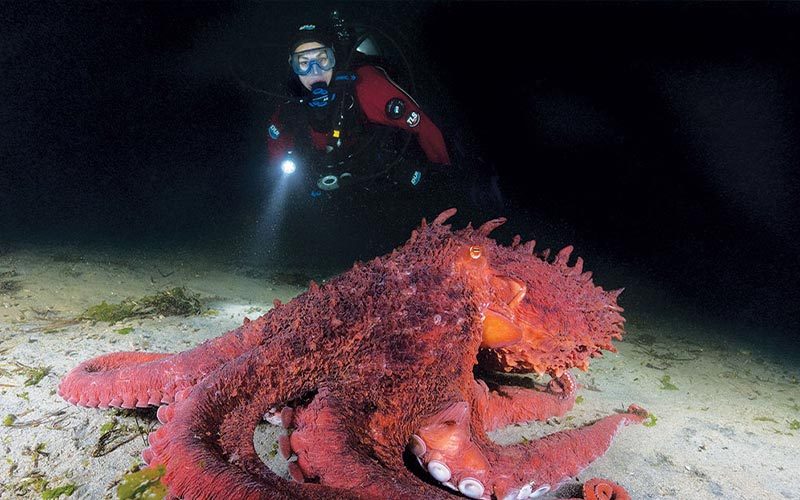
I’m more of a suckerhead and never miss an opportunity to seek out one of the world’s largest cephalopods: the giant Pacific octopus (GPO). A giant GPO’s arm span can reach 12 feet or more, though the average devilfish spans half that. No matter what the tape measure says, they are fascinating, engaging, clever beasts and rank highly on the wish lists of many divers who visit Vancouver Island. Many GPOs are creeping about in the Campbell River area. On our last trip, after finding two of pipsqueak proportions, we finally happened upon an 8-footer that was curious enough to spend 30 minutes interacting with us — yet another great BC memory I’m certain will come flooding back to me regularly.
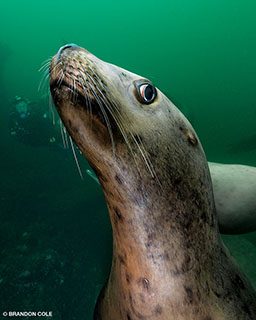
A must-do during winter months is Hornby Island for its Steller sea lions. You are unlikely to find more welcoming ambassadors to the Emerald Sea than these aquatic puppy dogs. Shambling hulks on land, they transform underwater into playful sprites (albeit multihundred-pound sprites up to 10 feet long) who seem genuinely thrilled to entertain guests. They gracefully twist and spiral around you, blow bubbles, bark and generally get up to all kinds of mischief — tugging your fins, giving you bear hugs with their flippers, nibbling your camera and, not uncommonly, nibbling you. Depending on your luck or karma, the sea lions’ enthusiasm at having new playmates can develop into full-contact wrestling. Some divers may find their good-natured attentions a bit unnerving; others won’t be able to get enough of them.
Nanaimo: Shipwrecks to Shore Dives
Though it’s situated in the middle of our tale, Nanaimo is by default the starting point for many Vancouver Island drive and dive odysseys. Having crossed the water via ferry from the mainland, you’ll find yourself in the heart of the Harbor City. Why not test its sheltered waters for a day or three before heading up island or over to the west side? It’s a great place to reacclimate to using your gills, get your shipwreck fix or dive on the cheap from shore.
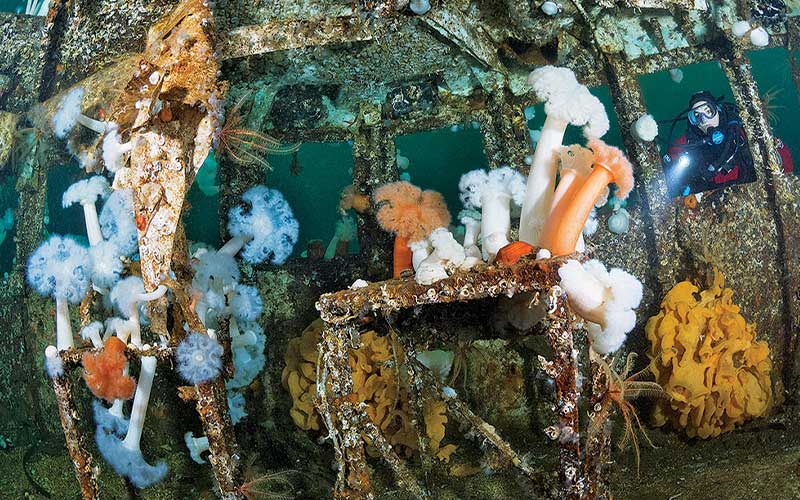
A main draw is undoubtedly Nanaimo’s wrecks. Two of Her Majesty’s naval fleet, the Saskatchewan and the Cape Breton, were meticulously prepared and then purposely sunk in 130 feet of seawater off Snake Island for their new mission in service of the dive community. What has transpired over the past 20 years is nothing short of exceptional. Both ships are now superb artificial reefs, home to rich assemblages of invertebrates and fish. On the HMCS Saskatchewan, a 366-foot-long Mackenzie-class destroyer escort, orange and white plumose sea anemones stand at attention inside the easily accessible bridge and decorate the radar platform, wreathing the wreck in an ethereal glow. Rockfish and lingcod loiter about, while baitfish shimmer above. Numerous passageways and rooms tempt divers into the shadows.
Right next door is the larger HMCS Cape Breton warship, truly massive at 442 feet long and about 10,000 tons. It too rests upright and is a pleasure to navigate. Anemones are in attendance, of course, as are fat cabezon, fields of feather stars and even small colonies of deepwater cloud sponge.
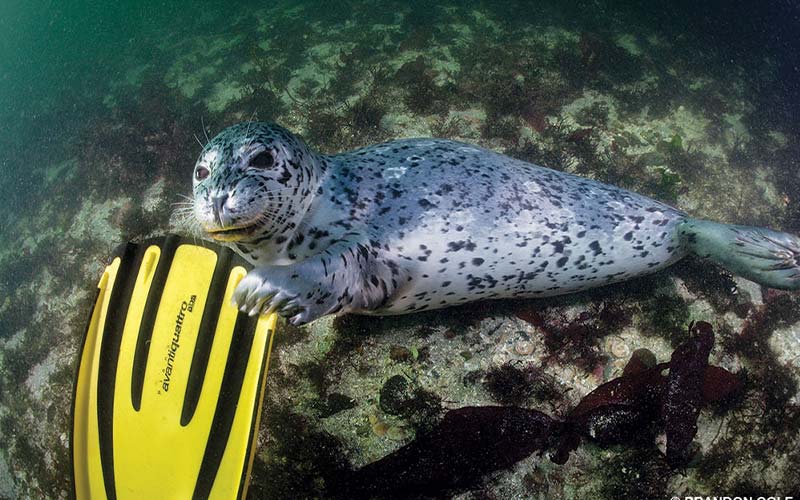
Clark Rock is regularly requested by those looking for a little wolf-eel love. Hunting among the boulders at 40 to 60 feet almost always yields at least a few of the snaggle-toothed, Muppet-faced monsters, some of which are quite friendly and slither right out of their lairs in expectance of a sea-urchin treat. Thirty minutes north of Nanaimo is Tyee Cove, an excellent, mellow shore dive popular for open-water training and another haunt of wolf-eels as well as perch, leather stars, swimming scallops and even GPOs. Octomaniacs will also like nearby Madrona Point, another top shore site and known hiding spot for multiple eight-armed rock stars.
Victoria: Splendid Diving Along Vancouver Island’s Southern Shore
Victoria has much to show for itself beneath the waves. And topside it’s a contender for first prize thanks to a brilliant mix of lovely weather, a happening city scene, tasty eats and plenty of active pursuits such as hiking, biking and whale watching. Pods of orcas are regularly sighted throughout summer and early fall, so your odds of seeing the Pacific Northwest’s totem animal slice through the sea and launch skyward in a breach are very high indeed.
We kick off things with a bang at West Race Rocks, whose claim to fame — besides strong currents and phenomenal marine life large and small — is its title as the first marine protected area in Canada. We cavort with sea lions in the shallows for 15 minutes while waiting for the ebb tide to peter out, then we weave our way through bull kelp stalks lined with hundreds of burgundy and silver-striped brooding anemones. As we get deeper, visibility opens up to 40 feet, and the thermometer registers a balmy 48°F. A shelving wall resplendent with urchins, hydrocorals and tunicates is our studio backdrop for a photo session with red Irish lords, decorator crabs and dahlia anemones. Only the incoming tide can send us back to the surface.
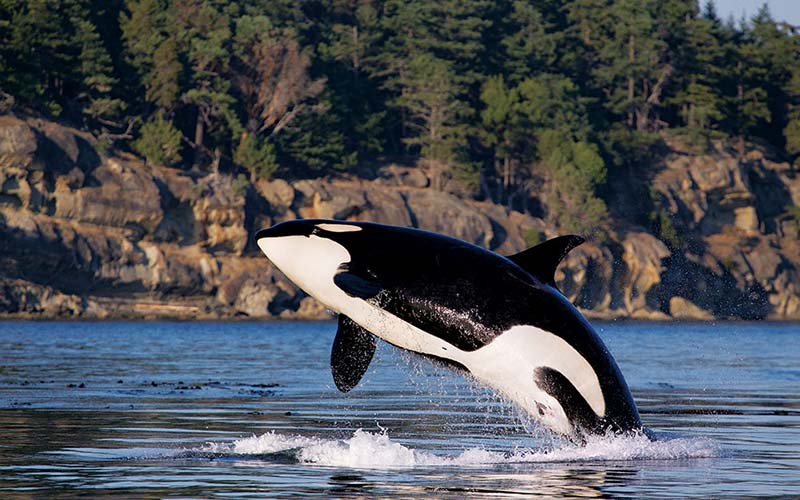
Back on board the boat, we motor west. Majestic and snow-mantled, Washington’s Olympic Mountains slide by on our left across the Strait of Juan de Fuca. Vancouver Island’s Metchosin and Sooke headlands are on our right shoulder. Swordfish Island can be dived off-slack and is an ideal follow-up to the current-dependent Race Rocks. This site’s signature feature is a swim-through on the northeast corner that’s sometimes hidden by a thick tangle of bull kelp. Inside the tunnel, which averages just 15 feet deep, we find walls draped in splendid soft coral and sparkling white anemones, perfect for wide-angle pictures.
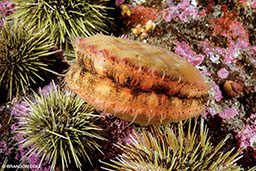
For an intro to fjord diving, drop deep at Senanus Island in Saanich Inlet north of the city. From 100 feet to beyond 150, cloud sponges in all their eerie beauty await. If the force is with you and the tides are right, a shore dive at current-sensitive Ten Mile Point in the eponymous upscale Saanich neighborhood offers remarkable macro photography. To shore dive with abandon even when the currents are screaming elsewhere, head to The Breakwater, the most popular dive in Victoria, day and night. Titan-sized stone blocks stacked neatly in tiers make for easy entry and provide prime real estate for marine denizens. We burn off the morning’s tea and crumpets by schlepping our gear a few hundred yards to submerge at dive flag marker 4.
Our pain, our gain. Underwater the weightlessness is bliss, and we glide down the steps to 65 feet. Heading east we spy gunnels in the kelp stalks and chitons on the rock blocks. Cranky crustaceans brandish claws, and triton snails lay eggs. Ling cod are everywhere, big and bold and glowering at us. My imagination calls forth a multilevel state penitentiary. The Breakwater inmates look like trouble, and their sinister gazes shift to follow our every move. In truth, the lings are lazy and happy, as spearfishing is prohibited here. And that makes us happy.
Barkley Sound: The Wild West Coast
Winding along Alberni Inlet, the water smooth and silver like the back of a 25-mile-long snake, we’ve escaped to Barkley Sound and the Pacific Rim National Park. It’s a rugged, remote wilderness. Bald eagles perch in hemlocks and cedars, while a black bear emerges from dense foliage to stroll the intertidal. Three humpback whales exhale explosively, lift their flukes with a flourish and dive down to feed.
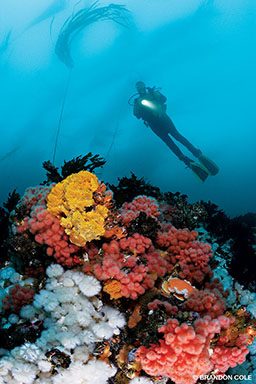
Situated on Vancouver Island’s outer coastline, the sound’s diving is notably different. Many species here — giant kelp, fish-eating sea anemones, certain reef fish, various bryozoans, the purple-ringed topsnail — are infrequently seen on the inside shoreline. This is due in part to the influence of the Pacific swell and surge that are a result of open ocean exposure. Barkley’s reefs have a look all their own. As a bonus, one can dive many sites just about any time instead of having to wait for slack. This is because water moves in all directions through the tight island groupings, which tends to nullify the current flow.
Renate Reef is a broad, plateau-topped seamount rising to within 35 feet of the surface. Divers must sometimes contend with surge, but the life here is well worth it. Mounds of staghorn bryozoans resemble a tropical reef’s coral heads and hide purple- and gold-ringed topsnails, camouflaged crabs and scalyhead sculpins. Strikingly scarlet vermilion rockfish hang deeper at the reef base. In the Kyen Point microcosm we discover a juvenile wolf-eel and electric-blue and gold opalescent nudibranchs sliming their way through a turf of iridescent algae. Yellowtail rockfish are in squadron formation in the kelp atop the saddle-shaped reef’s ridges. At Chris Rock we see shimmering ratfish, most alien in appearance, gliding over the sand bottom. We glimpse a swimming Stomphia sea anemone lift off the rock to escape a hungry leather star. A surprisingly cooperative decorated warbonnet with bulging eyes and a disheveled punk hairdo monopolizes my bottom time at Seddall Island Wall. Alas, no gas is left to pursue pictures of other little beasties.
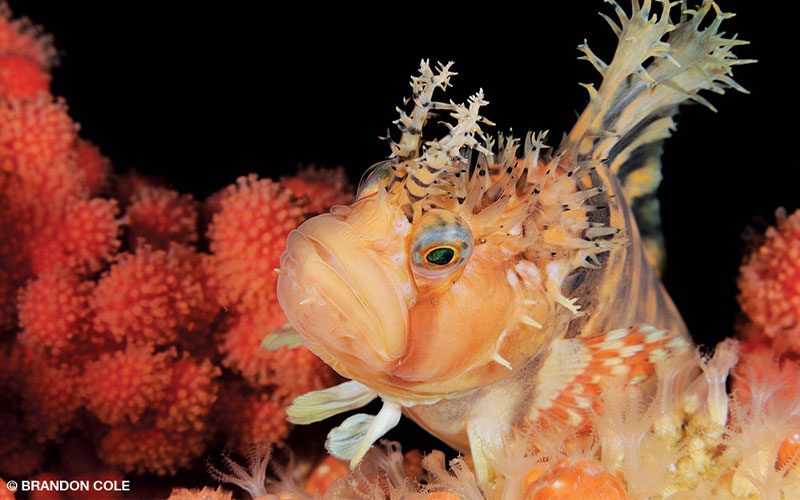
Barkley’s plankton-rich waters are stocked with giants. Sunflower stars 3 feet across roam about on 14 legs, plumose anemones resembling steroid-pumped cauliflowers tower everywhere, and GPOs lurk in dens by day, anticipating their midnight meals. Super-sized jellyfish pulse by like luminescent spaceships in orbit. The holy grail of the area’s megafauna, however, may be the sixgill shark. During summer months, target Tyler Rock for a chance to swim alongside this “Jurassic shark,” a primitive elasmobranch ancestral to modern five-gilled shark species. Tyler Rock is one the few sites on Earth where the very lucky diver might encounter, at recreational depths on scuba, these enigmatic slow-moving sharks that normally inhabit the deep sea.
As I descend through my buddy’s bubbles and strain to see the bottom somewhere down there in the gloom, I flash back to an epic dive here some 15 years ago. Memories come to life as a shadowy form takes shape.
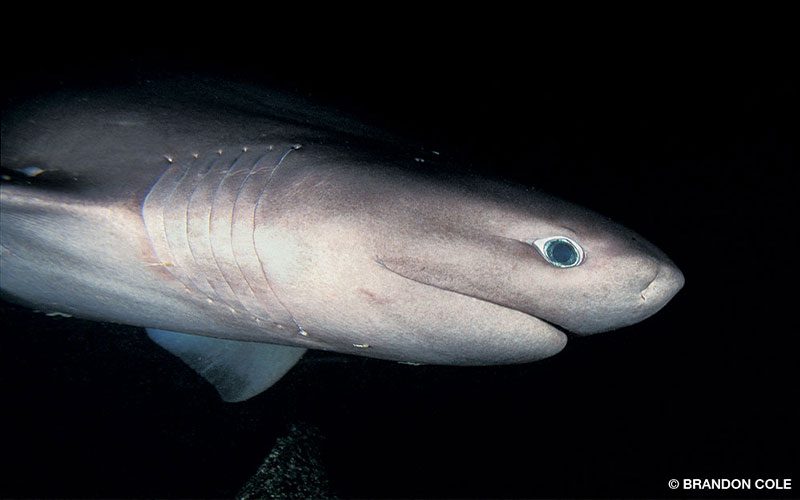
How To Dive It
Conditions: In general, Vancouver Island’s mild climate means diving and topside fun year-round. (Extreme weather is possible outside of Port Hardy during winter months, however, which can limit diving opportunities there during December through February.) Each diving region has its own best season, so check with local operators. In general, autumn and winter months have better visibility (averaging 30 to 80 feet). Summer months deliver more sun, warmer weather topside (65°F to 85°F, depending on the region) and usually calmer seas. The water temperature averages about 50°F but varies between 45°F and 55°F, depending on the region and season. A full 7 mm wetsuit, semidry suit or drysuit is required. Drysuits are recommended for multiday diving trips. Topside weather is often glorious in late summer and fall, with daytime temps in the 70s°F.
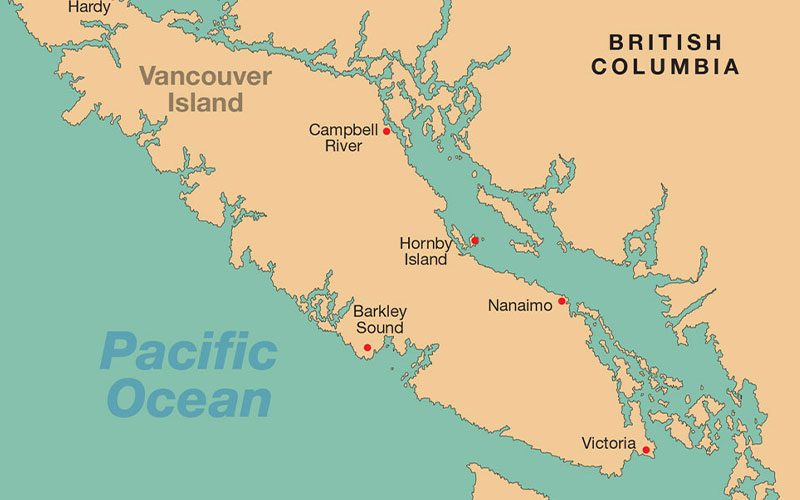
Tides and currents: For currents and tides, consult Canadian Tide and Current Tables at tides.gc.ca/eng/find/region/1. Caution: Make sure you also consult experienced local divemasters and boat captains. Slack water can be difficult to predict using only a printed chart. We strongly recommend you begin your Vancouver Island diving by going with experienced, local operators.
General Vancouver Island tourism information: hellobc.com/vancouver-island.aspx
Getting there: From British Columbia, take a ferry (bcferries.com) from Tsawwassen or Horseshoe Bay (near Vancouver city) to Nanaimo or Victoria. From Washington, take a ferry (wsdot.wa.gov) from Anacortes to Sidney (just north of Victoria). Victoria Clipper passenger-only ferries (clippervacations.com) connect Seattle and Victoria.
Access the following airports on Vancouver Island via Vancouver (city): Nanaimo (YCD), Victoria (YYJ), Port Hardy (YZT), Campbell River (YBL), Port Alberni (YPB).
| © Alert Diver — Q1 2017 |